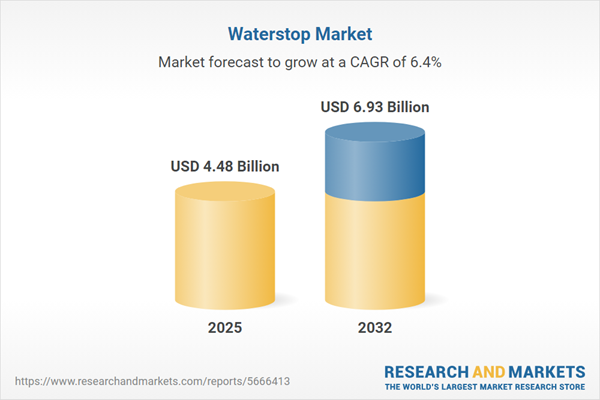Speak directly to the analyst to clarify any post sales queries you may have.
The waterstop market is rapidly transforming, shaped by advancing material science, evolving construction requirements, and expanding global infrastructure investments. This report equips industry leaders with the essential insights to optimize decision-making, navigate changing regulations, and capitalize on innovation-driven growth.
Market Snapshot: Waterstop Market Size, Growth, and Opportunities
The Waterstop Market grew from USD 4.21 billion in 2024 to USD 4.48 billion in 2025. It is expected to continue growing at a CAGR of 6.43%, reaching USD 6.93 billion by 2032. This momentum reflects accelerating demand for robust joint sealing solutions across infrastructure projects worldwide, including roads, bridges, dams, and critical water treatment systems. Market expansion is fueled by investments in sustainable materials, the need for greater operational lifecycle, and stricter environmental compliance.
Scope & Segmentation: In-Depth Coverage of Waterstop Solutions
This market research delivers comprehensive segmentation and analysis of the waterstop sector, covering a broad value chain and multiple geographic regions. The report provides forecasts and trend analyses across the following key areas:
- Material Types: Carbon steel, copper, stainless steel, modified polyvinyl chloride (PVC), standard PVC, chloroprene, EPDM, neoprene, polyethylene (PE), and thermoplastic elastomers (TPE).
- Application Areas: Construction joints (contraction, expansion, watertight), dam and reservoir joints, intake structures and spillways, sewage plant components, aeration tanks, screening units, sludge treatment, tunnels and mines, mining shafts, tunnel linings, underground structures, water treatment plants, clarification systems, filtration units, and membrane bioreactors.
- End Use Industries: Commercial buildings, infrastructure, mining, petrochemical and oil and gas, power plants, and residential projects.
- Distribution Channels: Offline (direct sales, distributors) and online models.
- Installation Types: Maintenance, new construction, and repair/retrofitting scenarios.
- Regions Covered: Americas (North America—including United States, Canada, Mexico—and Latin America with Brazil, Argentina, Chile, Colombia, Peru), Europe, Middle East & Africa (Europe—United Kingdom, Germany, France, Russia, Italy, Spain, Netherlands, Sweden, Poland, Switzerland—Middle East—United Arab Emirates, Saudi Arabia, Qatar, Turkey, Israel—Africa—South Africa, Nigeria, Egypt, Kenya), and Asia-Pacific (China, India, Japan, Australia, South Korea, Indonesia, Thailand, Malaysia, Singapore, Taiwan).
- Company Profiles: Sika AG, GCP Applied Technologies Inc., Fosroc International Limited, RPM International Inc., BASF SE, MAPEI S.p.A., Orio AB, De neef Construction Chemicals N.V., Hohmann & Barnard, Inc., SARMAT N.V.
Key Takeaways: Strategic Considerations for Senior Decision-Makers
- Technological advances in polymer engineering and metallurgy have led to longer-lasting, more resilient waterstop profiles, enhancing performance under a broad spectrum of environmental stresses.
- Emerging regulations for potable water safety and infrastructure resilience are compelling manufacturers and suppliers to adopt elevated certification and quality benchmarks across regions.
- Sustainability imperatives drive industry focus toward recyclable thermoplastic elastomers, with construction firms and public agencies increasingly demanding low-emission, longer-life waterstop solutions.
- Digital integration—including Building Information Modeling and advanced quality-control sensors—facilitates real-time performance verification, streamlined installation, and lifecycle management.
- Strategic regional diversification, especially amid changing tariff scenarios, ensures supply chain continuity and addresses shifts in procurement and cost structures.
Tariff Impact on Global Waterstop Supply Chains
Recent United States tariff measures have influenced material sourcing strategies and cost structures for waterstop manufacturers. Increased costs for imported compounds and elastomers are prompting companies to diversify their suppliers and form new partnerships with regional producers. Leading suppliers address these impacts through flexible contracting and advanced inventory management, which support continued project execution while maintaining quality standards.
Methodology & Data Sources: Robust Research Foundation
This report is built on a multi-phase approach, utilizing primary research with stakeholders such as material scientists, manufacturers, engineers, and procurement leaders. It integrates secondary research from standards, technical literature, and industry case studies, applying rigorous triangulation and peer-review checkpoints to validate the findings and ensure data reliability.
Why This Report Matters: Actionable Insights for Market Leaders
- Enables the development of procurement strategies aligned with regulatory, technological, and sustainability trends for improved risk controls and competitive positioning.
- Identifies growth opportunities across diverse market segments and regions, supporting tactical investment decisions and supply chain optimization.
- Empowers senior executives to anticipate and address evolving infrastructure needs by leveraging new material technologies and digital management tools.
Conclusion
The waterstop market is evolving as innovation, compliance, and partnership models redefine opportunities. This report provides a clear roadmap for confident planning and value-driven investment within the sector.
Additional Product Information:
- Purchase of this report includes 1 year online access with quarterly updates.
- This report can be updated on request. Please contact our Customer Experience team using the Ask a Question widget on our website.
Table of Contents
3. Executive Summary
4. Market Overview
7. Cumulative Impact of Artificial Intelligence 2025
Companies Mentioned
The companies profiled in this Waterstop market report include:- Sika AG
- GCP Applied Technologies Inc.
- Fosroc International Limited
- RPM International Inc.
- BASF SE
- MAPEI S.p.A.
- Orio AB
- De neef Construction Chemicals N.V.
- Hohmann & Barnard, Inc.
- SARMAT N.V.
Table Information
| Report Attribute | Details |
|---|---|
| No. of Pages | 187 |
| Published | October 2025 |
| Forecast Period | 2025 - 2032 |
| Estimated Market Value ( USD | $ 4.48 Billion |
| Forecasted Market Value ( USD | $ 6.93 Billion |
| Compound Annual Growth Rate | 6.4% |
| Regions Covered | Global |
| No. of Companies Mentioned | 11 |









